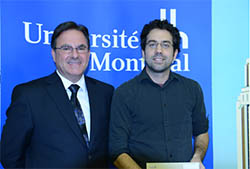2023 | 2022 | 2021 | 2020 | 2019 | 2018 | 2017 | 2016 | 2015 | 2014 | 2013 | 2012 | 2011 | 2010 | 2009 | 2008 | 2007 |
 Pier-Emmanuel Tremblay receives the prize for the best doctorate thesis from the Faculté des Etudes Supérieures et Postdoctorales (FESP) of the Université de Montréal.
Pier-Emmanuel Tremblay receives the prize for the best doctorate thesis from the Faculté des Etudes Supérieures et Postdoctorales (FESP) of the Université de Montréal.
The Faculté des Etudes Supérieures et Postdoctorales (FESP) of the Université de Montréal (UdeM) awarded the 2012 prize for the best doctorate thesis in fundamental sciences to Pier-Emmanuel Tremblay
Pier-Emmanuel Tremblay completed his PhD in 2011 at the UdeM Physics department under the supervision of Pierre Bergeron. The research presented in his thesis focuses on the study of white dwarf stars with hydrogen atmosphere (i.e., with a hydrogen-rich surface layer) of spectral type DA. More specifically, Dr. Tremblay improved the theoretical spectral models of these stellar remnants, by including both a new implementation of non-ideal gas theory and Stark-broadening unified theory. By comparing the generated grid of models to the observed spectra of these DA white dwarfs (from the Sloan Digital Sky Survey), he significantly improved the determination of their atmospheric parameters (temperature and surface gravity). He also addressed a long-persisting problem in this field of research, namely the abnormally-high surface gravity that is measured in cold DA white dwarfs. By making use of high-resolution spectra of white dwarfs obtained at the 10-m Keck telescopes (Hawaii), he demonstrated that the widely-accepted explanation for this phenomenon -- Helium contamination of external layers of the atmosphere -- is not supported by spectroscopic observations. Instead, Dr. Tremblay showed that the surface gravity anomalies can be solved by using hydrodynamic atmospheric models in three dimensions. Altogether, the results presented in the PhD thesis of Pier-Emmanuel Tremblay represent an important step in our understanding of white dwarfs with hydrogen-rich atmospheres.
Dr. Tremblay now works as a post-doctoral researcher with Professor Hans Ludwig at the University of Heidelberg (Germany), with whom he developed the first 3-dimensional atmospheric models for hydrogen rich white dwarfs. The prestigious Alexander von Humboldt postdoctoral fellowship he received in 2011 allowed him to make important progress in the understanding of these stars.
The CRAQ congratulates Pier-Emmanuel Tremblay for the prestigious award.
About the FESP awards: The annual awards ceremony of the FESP was created to put forward the academic excellence of graduate students at UdeM. It is also an occasion to thank university donators for the generous support provided to students. During the ceremony, the prizes for the best doctoral theses are awarded for each of the four major disciplines: Arts, Literature and Humanities, Social Sciences, Health Sciences, and Applied and Fundamental Sciences. This prize comes with a $1500 scholarship.
This web site is for Microsoft Internet Explorer and Firefox.
